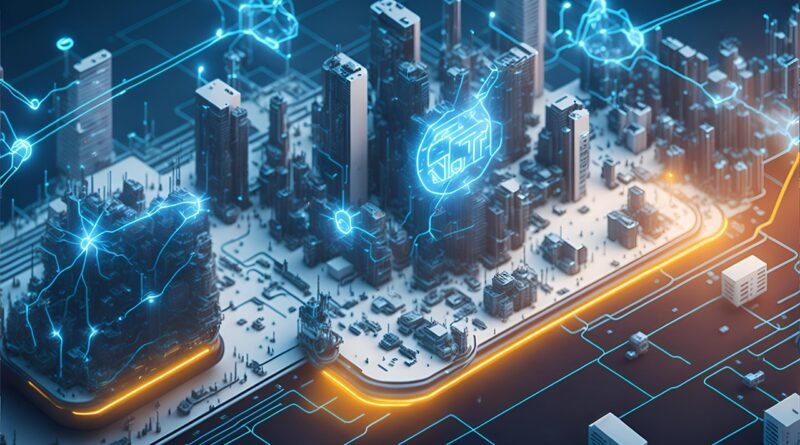June 2025 Tech Rundown: AI Reshapes Industries, Quantum Leaps Forward, and Sustainability Takes Center Stage
The tech world in June 2025 is a buzzing hive of innovation, with Artificial Intelligence continuing its rapid ascent, quantum computing making significant strides toward practical applications, and a strong emphasis on sustainable solutions shaping the future. From the boardroom to the device in your pocket, these trends are redefining how we live, work, and interact with the digital landscape.
AI’s Pervasive Presence: Beyond Efficiency to Competitive Edge
Artificial Intelligence (AI) remains the undeniable king of tech trends this month. While initial AI implementations focused on efficiency, 2025 sees a significant shift towards leveraging AI for a distinct competitive advantage. A recent survey revealed that over half of small businesses are actively exploring AI, with a quarter having already integrated it into their daily operations. The motivation is clear: 82% believe adopting AI is essential to stay competitive.
Key areas where AI is making an immediate impact include:
- Business Automation: A staggering 77% of businesses report that AI solutions for marketing and customer engagement would have the greatest impact, with strong willingness to automate content creation (84%) and customer service (59%).
- Financial Intelligence: Over half (53%) see AI-powered cash flow forecasting as a critical pain point solver.
- Predictive Analytics: 45% are highly likely to adopt tools that predict revenue trends, aiding in staffing, inventory, and marketing decisions.
- Real-time Customer Insights: 40% are eager for tools providing real-time trend analysis of customer buying behavior for dynamic pricing and promotions.
However, the rapid adoption isn’t without its challenges. Concerns around data privacy and security (38%), lack of time or resources (37%), and an uncertain ROI (34%) remain significant barriers.
Beyond business, AI is also seeing advancements in various sectors. Apple, while acknowledging some missteps in its Siri AI upgrade, is focusing on deeper AI integration across its ecosystem with a “Liquid Glass” redesign for iOS 26 and smarter features for its other operating systems. Meanwhile, the UK House of Lords is pushing for greater transparency regarding AI copyright, demanding developers disclose copyrighted works used in model training – a crucial debate for the creative industries.
Quantum Computing: Stepping Closer to Practicality
Once a theoretical marvel, quantum computing is accelerating towards tangible applications. This month, IBM made a groundbreaking announcement, unveiling its clear path to build the world’s first large-scale, fault-tolerant quantum computer at its new IBM Quantum Data Center. This ambitious roadmap envisions the “IBM Quantum Starling” as a system capable of running 20,000 times more operations than today’s quantum computers, utilizing revolutionary quantum low-density parity check (qLDPC) codes to drastically reduce the physical qubits needed for error correction. This represents a monumental leap towards stable and scalable quantum computation.
Adding to the excitement, a study published in Nature Photonics demonstrated that small-scale photonic quantum computers can outperform classical systems in specific machine learning tasks. This breakthrough highlights the potential for quantum machine learning to enhance algorithm speed, efficiency, and accuracy, while also offering energy efficiency advantages – a critical factor given the growing energy demands of AI and machine learning.
Cybersecurity in a Hyper-Connected World: A Constant Battle
As technology advances, so do the threats. Cybersecurity remains a paramount concern in June 2025, with an increasingly sophisticated threat landscape. Key threats to watch include:
- Advanced Ransomware: Attacks are predicted to become more destructive, targeting critical infrastructure and demanding higher payouts.
- AI-powered Cyberattacks: Cybercriminals are leveraging AI to create more personalized phishing attempts and real-time mutating malware, making traditional defenses less effective.
- Quantum Computing Threats: While still emerging, the future threat of quantum computers breaking current encryption standards is a growing concern, driving research into post-quantum cryptography.
- Supply Chain Attacks: These remain a prominent threat, exploiting vulnerabilities within an organization’s extended network.
- Insider Threats: Both intentional and accidental insider actions continue to be a significant vulnerability.
To combat these evolving threats, organizations are increasingly focusing on AI-driven security solutions for proactive threat detection and response, alongside strengthening traditional defenses like multi-factor authentication (MFA), robust endpoint protection, and incident response planning. The concept of a Cybersecurity Mesh Architecture (CSMA) is gaining traction, moving beyond siloed defenses to a more integrated and flexible security approach.
Sustainable Tech: Innovating for a Greener Tomorrow
The urgency of climate change is driving significant innovation in sustainable technology. In 2025, the focus is on creating a circular economy, enhancing energy efficiency, and leveraging tech to monitor and optimize environmental impact.
Key areas of sustainable tech innovation include:
- Green Energy Technologies: Continued advancements in solar, wind, and bioenergy are making renewable sources more efficient and cost-effective.
- Circular Economy in Technology: Emphasis on modular designs, repairable devices, and responsible recycling to reduce waste and extend the lifecycle of tech products.
- IoT for Sustainability: IoT devices are providing real-time data to monitor and optimize energy usage in smart cities, industries, and even homes.
- Carbon Capture Technology: Innovations in capturing and utilizing carbon dioxide from the atmosphere or industrial emissions are gaining momentum.
- Green Data Centers: The rise of cloud computing is leading to increased investment in carbon-neutral and energy-efficient data centers, often powered by renewable energy.
From eco-friendly consumer electronics to sustainable agricultural practices and the integration of green building materials, technology is playing a crucial role in the global effort to build a more sustainable future.
Looking Ahead
June 2025 highlights a dynamic tech landscape where innovation is not just about groundbreaking inventions but also about responsible deployment and addressing global challenges. As AI becomes increasingly embedded in our lives, quantum computing emerges from the lab, and sustainable practices become a core principle, the next few years promise even more transformative changes. The convergence of these trends will undoubtedly shape the technological narrative for the foreseeable future.

